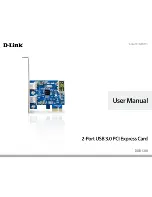
4
D-Link DWA-171 User Manual
Section 1 - Product Overview
Introduction
The Wireless AC Dual Band USB Adapter (DWA-171) delivers powerful wireless AC technology to your desktop or notebook computer. Simply plug
the adapter into an available USB port and connect to a wireless network to access a secure, high-speed internet connection – 2.4GHz (150Mbps)
or 5GHz (up to 433Mbps). And with integrated Dual Band technology, you’ll have reduced Wi-Fi interference to maximize throughput for faster
streaming, gaming, and Skype calls.
Interference-Free Bandwidth
The Wireless AC Dual Band USB Adapter(DWA-171) delivers Dual Band technology to your home network for intelligent, versatile, interference-free
bandwidth. Check your email and surf the Internet on the 2.4GHz band; or game, make Skype calls and stream HD movies to multiple devices using
the cleaner, interference-free 5GHz band. Whatever you like to do online, Dual Band has you covered.
Easy WPS Push Button Setup
Quickly and easily establish a fast, secure home network that will have you browsing, streaming, and watching in minutes. It’s as easy as push and
connect!
Compatible With All Your Wireless Products
While the Wireless AC Dual Band USB Adapter delivers cutting-edge 802.11ac speed to your home network, it’s also backward compatible with all
of your current wireless products – no updates or adapters necessary.
What is wireless AC?
802.11ac is a new networking standard that produces high-throughput wireless speed on the 5GHz band. What does this mean for your home
network? Flawless HD video streaming, faster gaming, and lag-free Skype and Facetime calls, all with less Wi-Fi interference for smooth, lightning-
fast performance. And while your home gains all the cutting-edge benefi ts of 11ac, D-Link’s Wireless AC Dual Band USB Adapter is also compatible
with all of your current Wireless N products.
“Maximum wireless signal rate derived from draft IEEE 802.11ac specification and IEEE Standard 802.11n specification. D-Link makes no warranties as to forward compatibility with future standards or compatibility with
draft 802.11ac devices from other manufacturers. Actual data throughput will vary. Network conditions and environmental factors, including volume of network traffic, building materials and construction, and network
overhead, lower actual data throughput rate. Environmental factors may adversely affect wireless signal range. Up to 433Mbps wireless speeds achieved when connecting to other 802.11ac devices. Data throughput may
also be limited by the product’s interface, less than 480 Mbps for a USB 2.0 interface. The inclusion of a specific product or manufacturer does not imply its endorsement of D-Link or the D-Link product. Computer must
adhere to Microsoft’s recommended System Requirements.”





































